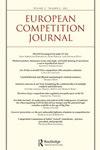Causation and counterfactual analysis in abuse of dominance cases – lessons from the General Court’s Qualcomm ruling
Q2 Social Sciences
引用次数: 0
Abstract
ABSTRACT Counterfactual analysis, which compares the competitive situation prevailing with and without the allegedly abusive behaviour, is nowadays regarded the lynchpin of an effects-based approach to the analysis of dominant firm conduct under Article 102 TFEU. This article draws on the recent Qualcomm ruling by the General Court of the European Union to critically reflect on the use and requirement of counterfactual analysis in abuse of dominance cases. It argues that Qualcomm offers two lessons on the role of the counterfactual analysis in modern competition law. First, it shows that counterfactual analysis is vulnerable to under-inclusiveness and type II errors when it ignores the problem of concurrent causes of foreclosure effects, disregards standard economic analysis of exclusivity rebates, and remains oblivious to dynamic competition. Second, Qualcomm sheds light on the intricate relationship between the counterfactual analysis and the requisite standard of harm for finding anticompetitive effects under Article 102 TFEU. In limiting the relevant counterfactual scenarios to a very narrow set of actual or nearby likely worlds, Qualcomm is but the last indication of a much more profound transformation of Article 102 TFEU: the transition from a capability to a balance of probabilities or beyond reasonable doubt standard of harm.滥用支配地位案件的因果关系和反事实分析——来自普通法院对高通裁决的教训
反事实分析比较了存在和不存在所谓的滥用行为的竞争情况,目前被认为是基于效应的方法来分析第102条TFEU下的主导企业行为的关键。本文借鉴欧盟普通法院最近对高通的裁决,批判性地反思反事实分析在滥用支配地位案件中的使用和要求。文章认为,高通在反事实分析在现代竞争法中的作用方面提供了两个教训。首先,它表明,当反事实分析忽视了丧失抵押品赎回权效应的并发原因问题,忽视了排他性回扣的标准经济分析,并且仍然无视动态竞争时,反事实分析容易受到包容性不足和第二类错误的影响。其次,高通公司揭示了反事实分析与根据TFEU第102条认定反竞争影响的必要损害标准之间的复杂关系。高通将相关的反事实情景限制在一组非常狭窄的实际或附近可能的世界中,这只是第102条TFEU更深刻转变的最后一个迹象:从能力过渡到概率平衡或排除合理怀疑的伤害标准。
本文章由计算机程序翻译,如有差异,请以英文原文为准。
求助全文
约1分钟内获得全文
求助全文
来源期刊

European Competition Journal
Social Sciences-Law
CiteScore
1.50
自引率
0.00%
发文量
12
期刊介绍:
The European Competition Journal publishes outstanding scholarly articles relating to European competition law and economics. Its mission is to help foster learning and debate about how European competition law and policy can continue to develop in an economically rational way. Articles published in the Journal are subject to rigorous peer review by leading experts from around Europe. Topics include: -Vertical and Conglomerate Mergers -Enlargement of the Union - the ramifications for Competition Policy -Unilateral and Coordinated Effects in Merger Control -Modernisation of European Competition law -Cartels and Leniency.
 求助内容:
求助内容: 应助结果提醒方式:
应助结果提醒方式:


